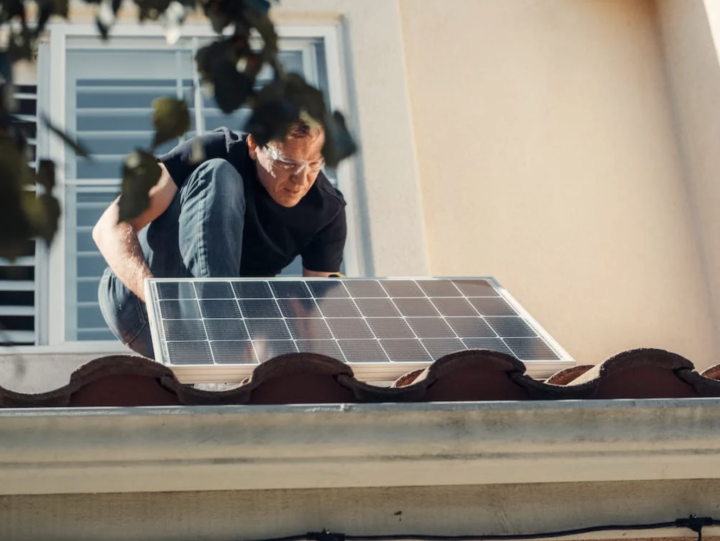Are you thinking about installing solar panels atop your home? It’s a great idea! In 2022, Americans established enough solar panels to power 22 million homes.
Solar energy is nothing new; the technology has existed for over a hundred years! In that time, we’ve learned that it could significantly help our energy needs.
We will cover the different types of solar panels in this article. Hopefully, this information will help you pick the best for your needs. Let’s get started!
Monocrystalline Panels
Monocrystalline panels have higher power density, which can generate more energy within a smaller space. They are made of single, pure crystal silicon. This type of solar panel is known for being the most efficient and durable available.
In addition, they have lower temperature coefficients. It means they are more effective in hotter conditions and can produce more energy. They are also the longest-lasting solar panels, as they can endure severe weather conditions better than others.
However, their higher efficiency comes at a higher cost. In terms of installation, monocrystalline panels require more expertise, making them better suited for professionals. If you are interested in one, make sure to consult a professional to determine the best solar panels for you.
Polycrystalline Panels
Polycrystalline panels give off fewer impurities compared to other types of solar panels. It reduces energy loss and increases efficiency. It comprises many smaller crystalline silicon wafers and utilizes the sun’s light energy to generate electricity.
This type of panel is slightly cheaper and less efficient than more efficient monocrystalline silicon panels. It comprises multiple silicon fragments; it’s still a reliable type of solar panel.
They are suitable for moderate amounts of sunlight and typically have an efficiency rate of around 15-18%. This efficiency rate is sufficient for most residential and commercial applications.
Thin-Film Panels
Thin-film panels are made up of various layers of materials, including an amorphous silicon film that is placed on a substrate. This solar panel is efficient, lightweight, and flexible. It also has the lowest temperature coefficient, which means it can run in any climate.
There are three main types of thin-film solar panels:
Amorphous Silicon (a-Si)
They use an ultra-thin layer of silicon material to capture and generate electricity from the sun’s energy. These panels are relatively lightweight and inexpensive to produce, and thus a trendy choice for solar energy applications.
Unlike cSi panels, aSi panels do not must as much direct sun exposure, making them an ideal choice for less sunny climates. They also do not degrade as quickly from exposure to sunlight, making them more cost-effective over the installation’s lifetime. All of these benefits come at the cost of relatively low efficiency, which typically comes in at around 10%.
Cadmium Telluride (CdTe)
CdTe panels offer a lower cost per watt and use less energy than other traditional panel types, making them an attractive choice for many. CdTe panels form a thin film of Cadmium Telluride semiconductor material layered over a substrate.
This semiconductor material is then exposed to sunlight, absorbing the energy and converting it into power. They store it as electrical energy before being sent to the grid. This provides a great alternative to traditional panel types and offers a strong return on investment.
CdTe panels are also an excellent alternative for those looking for a more efficient means of generating energy. They have limited space for their system.
Copper Indium Gallium Selenide (CIGS)
They are thin film technologies made from copper, indium, gallium, and selenide. They offer higher efficiency rates in a smaller and lighter package than the traditional silicon-based panels. CIGS cells absorb the sun’s photons and convert them into a direct current voltage.
They have an efficiency range of 10-17%, though the highest efficiency reported is 21% for CIGS thin films. CIGS solar cells have become increasingly popular because they can be used as flexible and lightweight materials and boast a long lifespan.
They are an excellent choice for those who wish to save space and include them in small or oddly shaped solar systems. They can also generate energy in more challenging environmental conditions, such as cold temperatures, making them an excellent choice for remote locations.
PERC Panels
It was developed by SunPower and is the most efficient solar panel on the market. PERC solar panels are generally smaller and more efficient compared to traditional panels. They have a higher cell conversion rate of more than 21%.
They must have less space for the same level of energy output. They can be used in both on-grid and off-grid applications. PERC technology also features improved temperature coefficient efficiency.
Power output will stay stable and consistent even in higher temperatures. PERC solar panels come with a guarantee that guarantees performance for many years. It makes them an excellent long-term investment.
Hybrid Solar Panels
The technology in hybrid solar panels allows them to convert the sun’s radiation into electricity. As a result, hybrid solar panels offer a more comprehensive and efficient way to use the sun’s renewable energy. They reduce heating and cooling bills.
They often produce more electricity at cooler temperatures than conventional panels. This makes them an ideal choice for homes in areas with frequent hot summers.
They can be a great investment for both monetary and environmental benefits. They are a common choice for residential energy solutions.
Hybrid solar panels combine technology to maximize efficiency and reduce costs. Hybrid solar panels are more expensive than traditional panels but may be more cost-effective in most situations, depending on the application.
They also tend to have higher energy efficiency and must have less roof space for installation. It is a good choice for those who want the benefits of solar energy but need a more affordable choice.
Choose the Best Types of Solar Panels
Solar panels are a fantastic way to reduce energy costs and help protect the environment. People should consider the different types of solar panels to maximize efficiency and cost savings for their homes or business. With the other options available, there’s sure to be one that fits each individual’s needs!
Check out our other blog posts and learn more today!
















